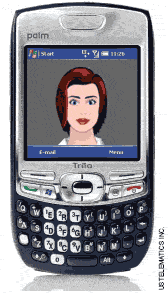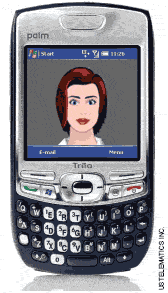
This animated redhead is designed to keep you less distracted on the road.
Driving While Intexticated?
 As the Darwin Awards annually demonstrate,
there are those among our
species who shun common sense. Fortunately
for the collective gene pool, these
individuals usually prove they are not the
“fittest” and suffer the consequences. It
doesn’t take DA contenders, though, to
routinely threaten the survival of themselves
and all in their vicinity. Case in
point: According to a survey by Nationwide
Insurance, nearly one in five people
send and receive text messages while driving,
an equation that adds up to millions
of Americans steering with their pinkies
while their eyes are on something other
than the road.
As the Darwin Awards annually demonstrate,
there are those among our
species who shun common sense. Fortunately
for the collective gene pool, these
individuals usually prove they are not the
“fittest” and suffer the consequences. It
doesn’t take DA contenders, though, to
routinely threaten the survival of themselves
and all in their vicinity. Case in
point: According to a survey by Nationwide
Insurance, nearly one in five people
send and receive text messages while driving,
an equation that adds up to millions
of Americans steering with their pinkies
while their eyes are on something other
than the road.
Now, the list of what not to do while
operating a motor vehicle is long, but if
typing—even on a palm-sized keyboard—
isn’t right up at the top along
with drinking, sleeping, and applying
makeup or shaving, it should be. Last
year, nine states considered legislation
specifically banning driving while texting,
and Washington became the first to
make it official, passing a law that took
effect in January. But is this necessary?
Don’t we know that distracted driving is
dangerous? Has our mania for multitasking
suddenly superseded sanity?
Who are these one in five people?
Meet Charlene Montalbano. She
pleads guilty to texting while driving and
describes it as a sort of addiction. “I’d say
it’s a habit,” she admits. “Human nature
being what it is—because we’re so
curious—when we hear that chime go off,
we want to know what that message is.
I’ve been awoken at 4 o’clock in the
morning by a text message because I am so
tuned in to the sound of that chime. You
have to see it. I mean, it’s a 24/7 society,
and people want to be connected. We’re
conditioned to be connected.”
Before judging her too harshly, you
should also know that, as director of
product management for USTelematics
Inc., a technology company in Wood
Dale, Ill., Montalbano is in a unique position
to help those who share her addiction
while also making the roads safer for
the rest of us. She’s doing this with a software
program named Vivee, which is
short for “Voice interactive, voice
enhanced email” and also the name of the
animated female avatar the program
employs to stream your incoming text
and email messages
and read them to you,
allowing your eyes
and hands to stay
occupied with driving.
Seeing Red
Once uploaded into
your Windows mobile
device, cell phone,
hand-held GPS, or
other PDA, Vivee will
check in real time
about every 10 seconds
for new messages.
Once it finds
one, “she” will sound
a warning chime and
then automatically
read it to you—up to
50 lines. “It’s nice
because you can just leave [the device] in
its phone holster in your car and just
continue driving,” Montalbano says. “If
there are times when somebody’s in the
car with you and you’d rather her not
read it to you, you can put it into a
manual mode, which is as simple as
changing the preference.”
Vivee works via a text-to-speech
engine that Montalbano hand-picked for
its massive word library. The result is that
Vivee’s vocabulary is extensive and even
includes most textspeak (e.g., “CUL8R”
for “See you later!”), common foreign
words and phrases, and, um, swear words.
“It can be funny,” Montalbano says.
“When I was doing the beta testing, I had
to know the limitations of the product, so
I came up with the 20 nastiest words you
could think of, and she went ahead and
said them. She’s not shy.”
Montalbano notes that the program
also features a male avatar, which she
chose for his striking resemblance to
Anderson Cooper. “He’s not as popular
and does not have a catchy name, but he
does have a distinguished voice,” she says.
Both animated characters bring full wireless
Internet connectivity with them at
speeds on par with many DSL services
when fully installed in compatible devices.
“CUL8R”
A downside of the program is that currently
it works only one way—translating
the incoming message to speech.
To respond, you still
have to rely on the conventional
(and dangerous,
if not illegal)
method of thumbing the
keypad. But Montalbano
says USTelematics
is working right now to
correct this problem
and expects to offer a
voice-to-text module in
coming months.
Another potential
problem (for me,
anyway) is that even
though Vivee allows you
to keep both hands on
the wheel, she doesn’t
entirely remove the element
of distraction. I find
her distracting in the
same way hands-free phones are, in that it
is not the device itself but the actual conversation
that is attention-diverting. Plus,
it doesn’t at all help that her big blue eyes
actually blink as she reads.
This article originally appeared in the May 2008 issue of Occupational Health & Safety.